
5 proven strategies to reduce shopping cart abandonment
According to Forrester, cart abandonment causes e-commerce brands to lose $18 billion in yearly sales revenue. Though cart abandonment is inevitable, there are things e-commerce brands can do to decrease abandonment rates. Consistently analyzing performance and discovering fresh approaches to avoid abandonment can help boost sales. Even small adjustments can result in decreased abandonment rates and increased revenue.
Key takeaways
Understanding why customers abandon their carts can help you optimize the customer experience and increase conversions
A digital experience intelligence platform can help you quantify losses from cart abandonment
There are proven strategies that you can implement to decrease your cart abandonment rate
What is shopping cart abandonment?
Cart abandonment happens when an online shopper adds items to their basket but fails to complete the checkout process or cancels the order before making the transaction.
Cart abandonment rate is calculated by dividing the total number of completed transactions by the total number of add-to baskets that didn’t result in a sale. Then, the result is subtracted from one and multiplied by 100.
Watch this Survey Monkey video to learn the basics of cart abandonment.
The impact of cart abandonment
Shopping cart abandonment is a plague on the e-commerce industry. Online shoppers have many options to purchase products. Friction in the checkout process means they will likely turn to another source.
Cart abandonment has a direct impact on a company’s revenue, with an average loss of $417,814.92 in the first quarter of 2022.
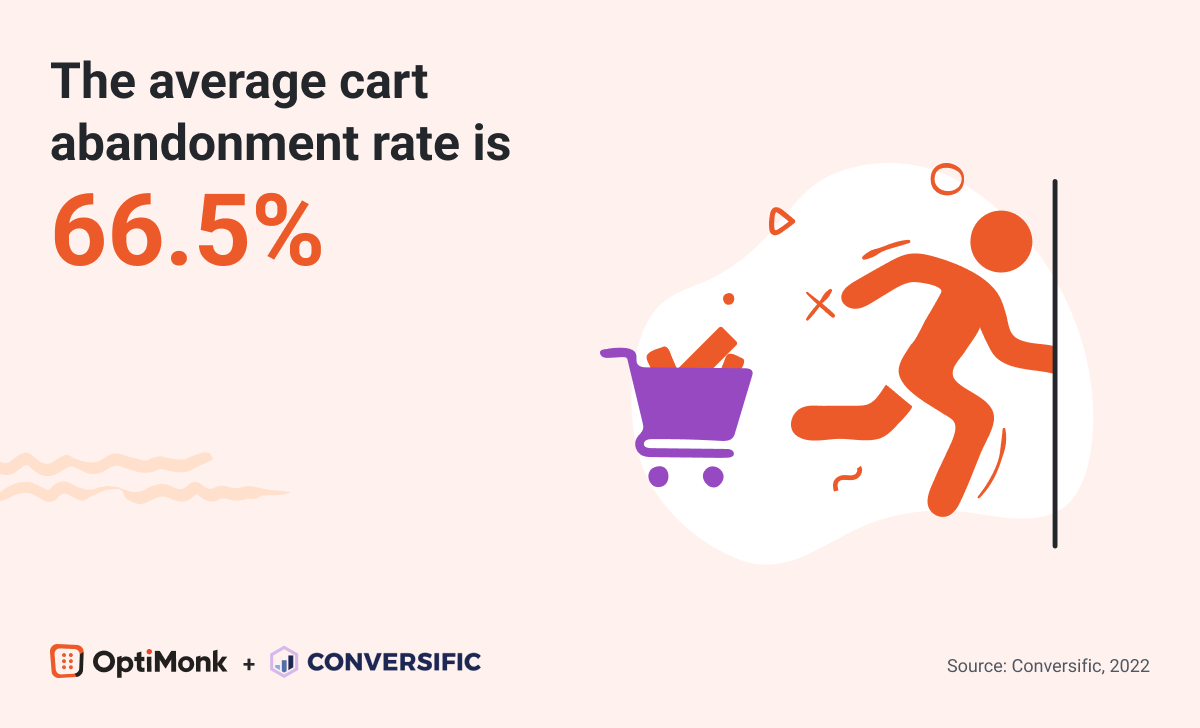
Abandoned carts can also be quite costly for both customer acquisition and customer retention efforts. Customer retention is incredibly valuable for e-commerce brands, as research from Bain & Company reveals that increasing customer retention rates by 5% increases profits by 25% to 95%. According to the Harvard Business Review, the cost of new customer acquisition is anywhere from 5 to 25 times higher than retaining an existing customer.
The long-term effects of cart abandonment on customer loyalty cannot be overstated. As Modern Retail points out, e-commerce brands lose out on lifetime value when an existing customer abandons their cart due to too much friction in the online checkout process.
Benefits of reducing cart abandonment for businesses
When the online checkout process is seamless, customers are much more likely to complete a purchase. This directly affects a business's potential to increase revenue and profit margins. Satisfied customers are also more likely to remain loyal to the brand and return for future purchases.
Nothing hurts an e-commerce brand more than a poor customer experience. Businesses that are attentive to their cart abandonment rates–and the reasons why the cart is abandoned–are more likely to enjoy an enhanced brand reputation and greater customer retention.
10 common reasons for cart abandonment
There are many reasons customers add items to their cart and then abandon them. We’ve rounded up 10 of the top reasons below.
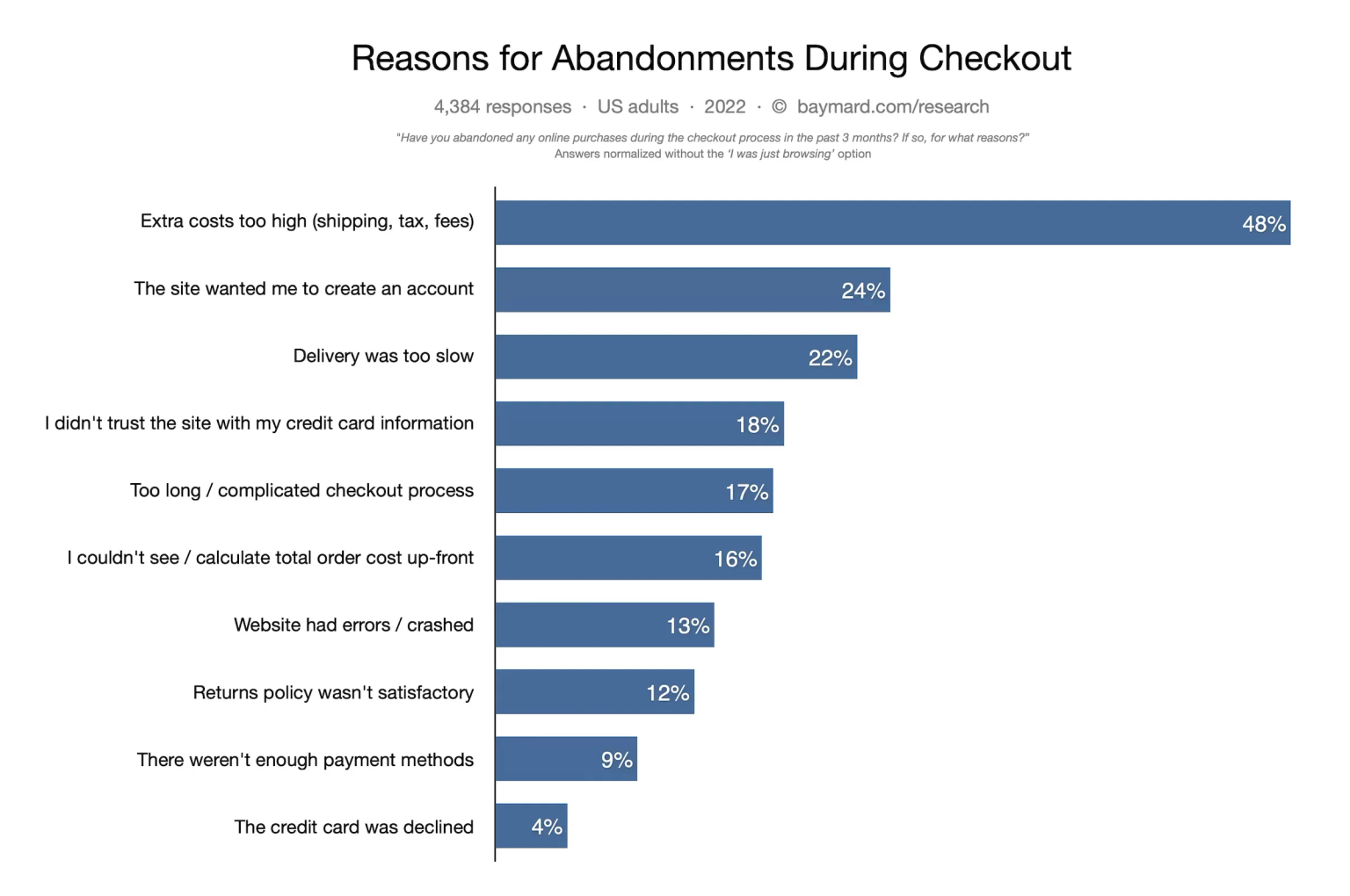
48% of online shoppers abandon their carts due to extra costs such as shipping, tax, fees, etc. (source)
24% of online shoppers abandon their carts because they were required to create an account (source)
17% of shoppers abandon their carts because they found the checkout process too long and complicated (source)
16% of shoppers abandon their carts if they couldn’t see or calculate the total order cost up-front (source)
13% of online shoppers abandon their shopping carts if the website had errors or crashed (source)
57% of online shoppers will abandon their carts if they’re forced to wait for it to load for 3 seconds or longer (source)
46% of buyers abandon their carts because a discount code doesn’t work (source)
55% of people abandon their shopping carts if they have to re-enter their credit card or shipping information (source)
17% of online shoppers abandon their cart due to lack of trust of the website (source)
39% of mobile users abandon their shopping cart because of difficulty entering their personal information (source)
🔥Hot tip: A digital experience intelligence platform, like Glassbox, can show you why customers abandoned their carts.
Looking for more shopping cart abandonment statistics? Check out the blog Cart abandonment: 15 important statistics to know.
Shopping cart abandonment by industry
Bayard Institute’s 2023 Cart Abandonment Rate Statistics list paints a grim picture. Reviewing 48 sites, BI calculated an average cart abandonment rate of 69.99%. That’s a whopping 70% of revenue lost (or even more, considering customer loss) to friction in the online checkout process, with only an average of 3 in 10 people completing the checkout process.
Some of this can be attributed to people simply browsing a site or comparison shopping between sites selling the same items. But streamlining and simplifying the user journey through the checkout process can help lower abandonment rates. Here’s a look at cart abandonment rates by industry:
Industry | Cart abandonment rate |
Automotive | 89.11% |
Airlines | 88.87% |
Fashion | 88.57% |
Travel | 85.22% |
Baby & child | 85.1% |
Hotel | 82.71% |
Retail | 76.34% |
Sports & outdoor | 75.67% |
Cosmetics | 75.35% |
Pharmaceutical | 71.51% |
Consumer electronics | 70.65% |
Groceries | 61.13% |
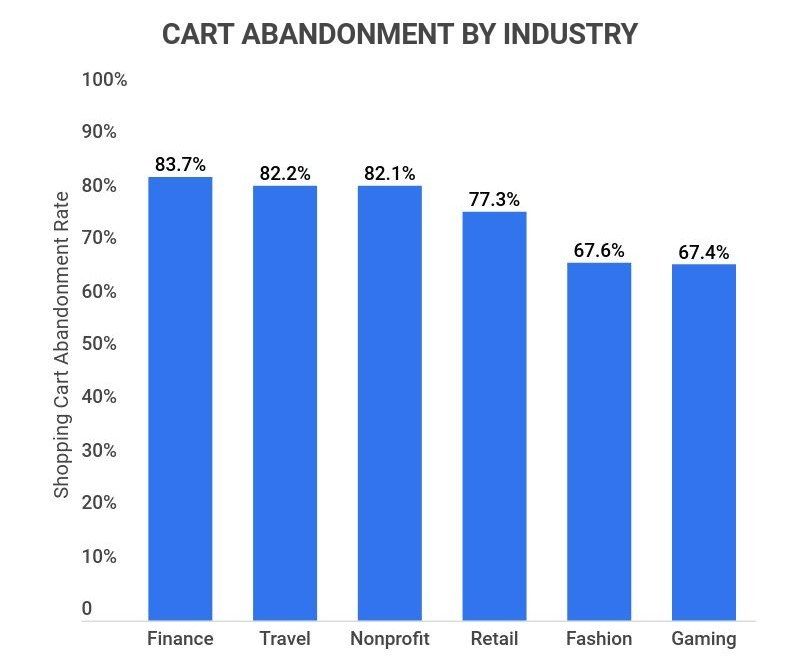
How to identify shopping cart abandonment
The first step in identifying cart abandonment is using a tool to see the abandonment rate. There are a variety of solutions available to identify this information and some e-commerce platforms have built-in functionality that provide this data.
However, many of these technology solutions can only tell you what a user did during the checkout process. Not why they did it. With a digital experience intelligence (DXI) platform, you can uncover the what and why–which empowers you to take more informed actions to reduce online shopping cart abandonment in your e-commerce store or mobile app. Advanced DXI insights will also help you analyze performance regularly and help you discover different approaches to decrease cart abandonment.
Quantifying losses from shopping cart abandonment
A DXI platform like Glassbox can help you detect any type of issue impacting online transactions and uncover the amount of revenue lost to cart abandonment. It combines the two data points and presents them in a real-time dashboard. This gives businesses complete insight into how customers interact with a website or mobile app and quantifies the loss in revenue.
The platform automatically captures 100% of the data and enables e-commerce sites and mobile apps to identify where customers struggle, diagnose root causes, and assess the source of the challenges. By combining AI and machine learning-powered alerts, you can learn in real-time when there is an abnormal amount of transactions–or a very large transaction–that fails to be completed. Then you can remedy the issues quickly and optimize the customer experience.
Strategies to reduce shopping cart abandonment
Every online cart has a mini funnel that can be analyzed to determine why a shopper abandoned their cart. If a shopper saw the price of an item and dropped out, you have a price issue. If they left when they got to a form, then it’s a form issue. If they tried to enter their credit card number and left, something is likely wrong with the payment form.
If they had a coupon and tried to enter it but abandoned their cart, there might be a problem with the coupon field. Telling a user their password setup didn’t meet the specified criteria can also lead to cart abandonment. The worst scenario is if a shopper clicked pay, but didn’t pay–that means the payment button is likely broken.
Below are five strategies you can implement to help you minimize cart abandonment.

1. Simplify the checkout process. According to research, 81% of website visitors abandon an online form while filling it out. Asking for too much information on the form–or requiring information the shopper doesn’t want to share, like a phone number–increases the chance of cart abandonment. If you identify a high rate of abandonment when the shoppers get to the form, then it’s time to take a look at the UX data and see how you can simplify the form.
2. Improve the speed and functionality of your website or mobile app. If shoppers have to wait too long for pages to load or for the next stage of checkout to appear, many will get frustrated and leave. A lack of intuitive functionality can also drive cart abandonment.
3. Offer free incentives. Free incentives are an excellent way to reduce cart abandonment. If you notice that a shopper dropped off when they saw the total cost for the items in their cart, offer them free shipping to try to get them back. Sending them a coupon from the brand’s CEO is another good, memorable incentive for the shopper to return. If someone fails to complete the purchase a number of times, you could have a pop-up with a discount offer to try to keep them in their cart.
4. Perform an ad-hoc funnel analysis. This gives you a full understanding of the shopper’s checkout journey and removes time from the process of figuring out why a cart was abandoned. The funnel analysis tool within the Glassbox platform captures 100% of digital events and puts the data right at your fingertips so you can understand the impact of issues and remove friction points from the checkout process. The tool also sends alerts when issues arise so you can react quickly to high-priority problems.
5. Implement a digital experience intelligence solution. A DXI solution will have tools like session replay and heatmaps to give you a visual representation of everything the customer sees while interacting with your website or app. Session replay automatically captures all of the user interactions and technical events–then delivers a video-like replay so you can find the root cause of struggles and errors quickly. Heatmaps show you where users click, tap and scroll and can help you identify struggle points or friction.
Use abandoned cart emails to win customers back
Abandoned cart emails are communications sent directly to the shopper who abandoned their cart to re-engage them with your brand and get them to return to their cart. It’s also a way to help tether shoppers to your brand and recover lost revenue. Investing in cart abandonment emails really pays off, since according to research, 48% of abandoned cart emails are opened.
How to use cart abandonment emails
Abandoned cart emails are automatically triggered when a shopper leaves items in their cart. Remember that the shopper left their cart for a reason–maybe they were just browsing or they experienced friction in the checkout process. So, make the email stand out.
Offer incentives in the email to make the purchase now: free shipping, discount codes or coupons. Name the items that are in the shopper’s cart. Include reviews or positive social feedback to gain trust. It's really important to make sure the email doesn’t get lost in a sea of other emails the shopper receives. Write an attention-getting subject line and include vibrant visuals along with simple, yet engaging body copy. There should also be a strong call to action (CTA) like a checkout button.
Best abandoned cart email examples
Here are a few well-done abandoned cart emails. Notice the fun visuals and snappy copy–that’s the key to generating attention for your abandoned cart emails.
1. Example of an abandoned cart email from Sephora

2. Example of an abandoned cart email from Away
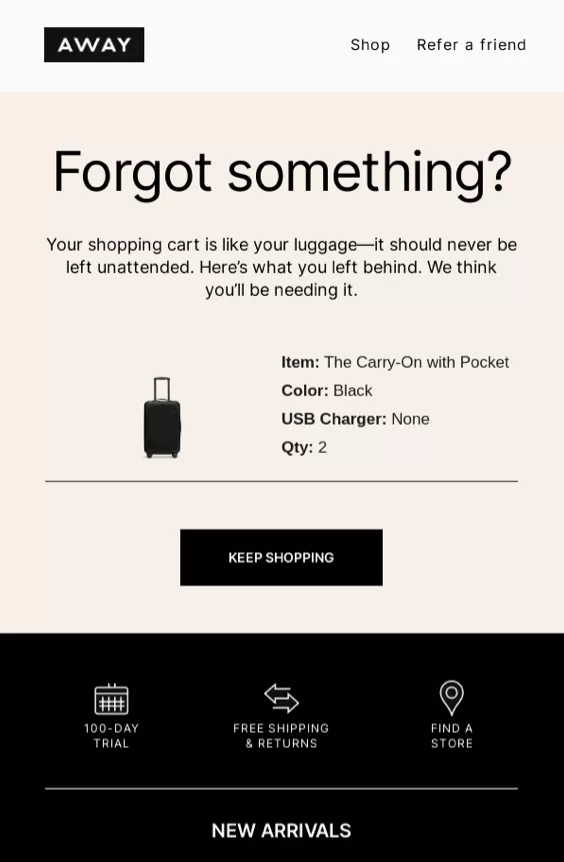
3. Example of an abandoned cart email from Target
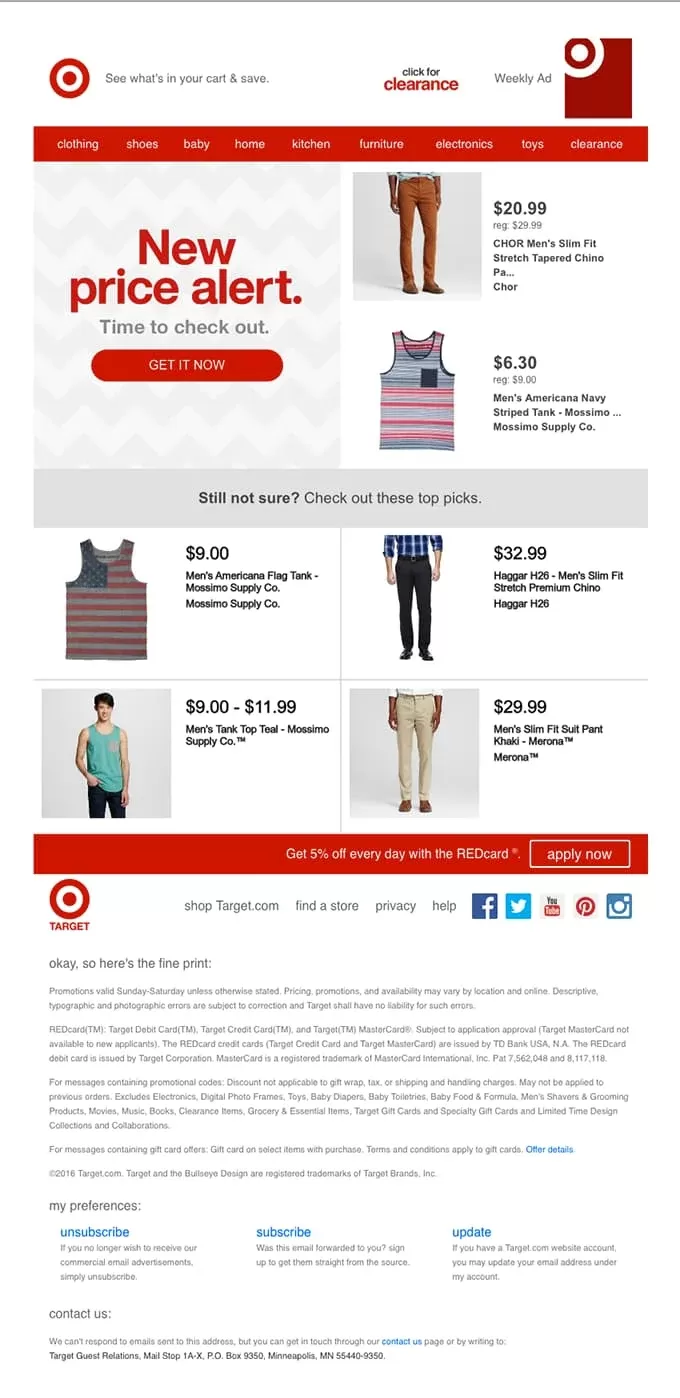
4. Example of an abandoned cart email from Luno

Minimize cart abandonment with Glassbox
Glassbox’s digital experience intelligence platform can help you minimize cart abandonment by giving you the tools to optimize digital customer experiences and drive greater conversion rates and improved profits. See how Glassbox is helping online retailers here.
FAQs
Q: What is abandoned cart recovery?
A: Abandoned cart recovery combines marketing automation tools and best-in-class UX design principles as a strategy to combat lost revenue due to online cart abandonment.
Q: Who picks up abandoned shopping carts?
A: There’s a high chance a competitor selling the same or similar product picks up the sale if an e-commerce site or mobile app has friction in the online checkout process.
Q: How can you convert abandoned carts?
A: Highly engaging and visually attention-getting abandoned cart emails are a very effective way to re-engage shoppers who left items in their cart without making a purchase, encouraging them to return with discounts, coupons and free shipping.
Q: How can you reduce shopping cart abandonment?
A: Shopping cart abandonment can be reduced through a variety of actions such as:
Simplifying the checkout process
Improving website speed and functionality
Offering shipping incentives and discounts
Performing funnel analysis
Using a digital experience intelligence platform that includes tools such as session replay and heatmaps





